Botany Exam 2
1/152
There's no tags or description
Looks like no tags are added yet.
Name | Mastery | Learn | Test | Matching | Spaced |
|---|
No study sessions yet.
153 Terms
tap root system
dicots
fibrous root system
monocots
pneumatophores
specialized roots used for breathing (mangroves)
shoot region order + vascular tissues
root cap → cell division → elongation → maturation
(outtermost → innermost): ground meristem → endodermis → phloem → xylem
Epidermis function
outermost layer for absorption.
Produces root hairs to increase surface area
Cortex function
storage tissue
Endodermis function
The barrier for water and minerals
before entering vascular tissue
Pericycle function
Lateral roots emerge from this layer
Vascular bundle function
Transport of water and food
root tissue order (outer to inner)
epidermis → cortex → endodermis → pericycle → vascular bundle
Casparian strip
stops the non-selective absorption
of materials into a root from soil
lateral meristems
Dicot plants develop lateral meristems to increase girth (width)
by secondary growth
Lateral meristems are secondary meristems.
Secondary meristems and secondary growth are not seen in monocots
What is wood?
The secondary xylem is responsible for the “wood” in stems and roots of woody dicot plants
bark and wood diagram
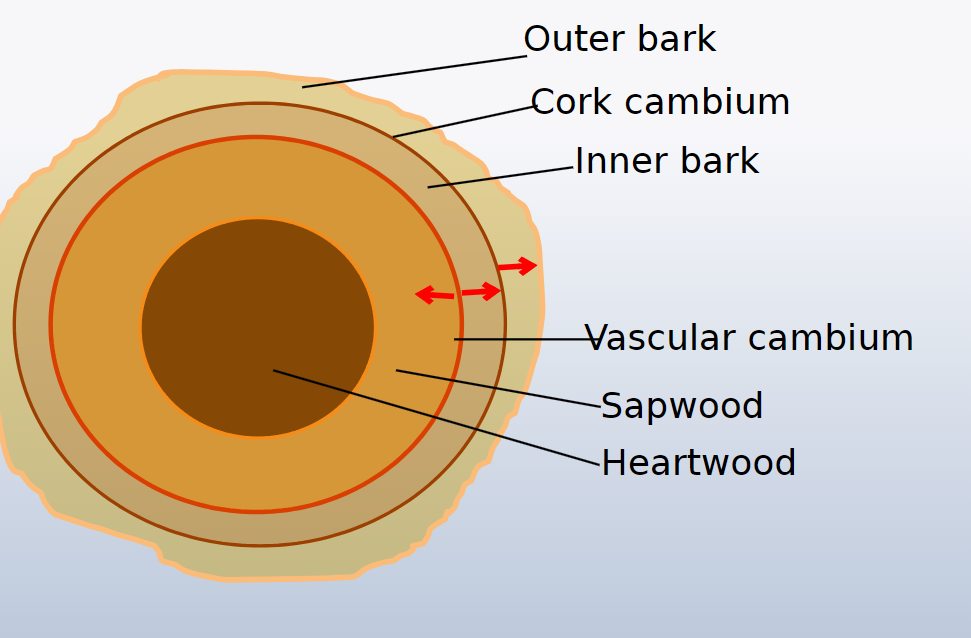
lead anatomy diagram

alternate leaf arrangement
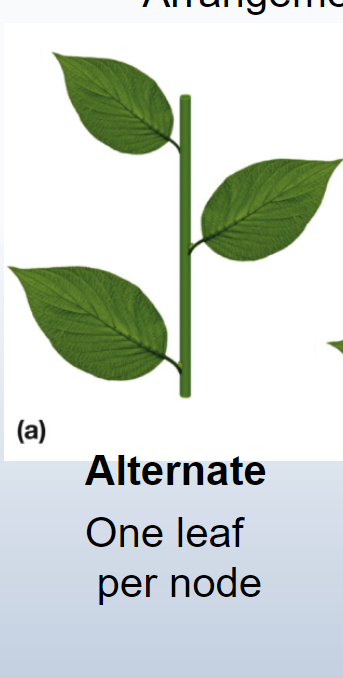
opposite leaf arrangement
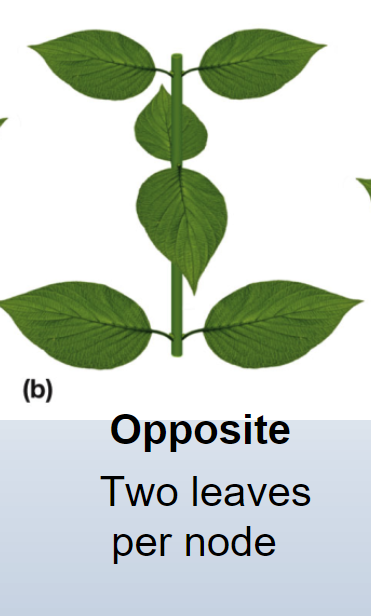
whorled leave arrangement
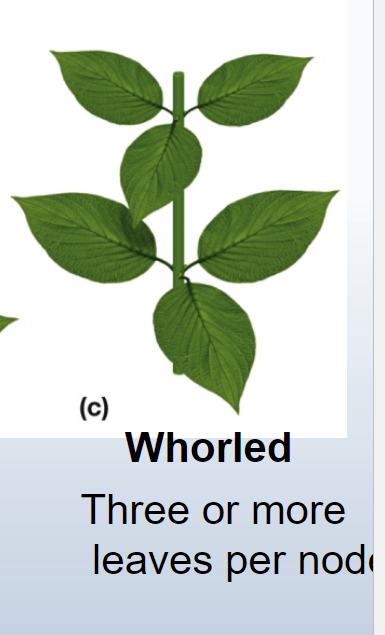
dicot leaves
Reticulate venation
Petioles
Kidney-shaped stomata
monocot leaves
Parallel venation
Sheath-like leaf base
Dumbbell-shaped stomata
venation
an arrangement or system of veins
upper epidermis of leaf
- usually coated with a waxy cuticle
- contains few stomata
mesophyll cells of leaf
- The main photosynthetic tissue
- arranged as palisade and spongy in dicots
- undifferentiated in monocots
lower epidermis of leaf
-thinner cuticle
- contains many more stomata
the mid-rib of a leaf contains the
vascular bundle
palisade parenchyma
converts the light energy to the chemical potential energy of carbohydrates.
spongy parenchyma
allow for the interchange of gases (CO 2) that are needed for photosynthesis, photosynthesis
typically the stomata on a leaf are located in the
lower leaf epidermis
stomata purpose
gas exchange, transpiration occurs through these
stomata’s guard cells use
turgor pressure to open and close, turgid → open flaccid → closed
subsidiary cells surround the
stomatal guard cells
Guard cells and subsidiary cells work together to
regulate the K+ ion concentration
Xerophytes
(arid climate plants) Shiny surface
Thick waxy cuticle
Trichomes (hairs)
Sunken stomata (stomatal crypts)
Multi-layer epidermis
Sunscreen chemicals in the epidermis
There are no stomata in the upper
epidermis
Hydrophytes
ex. water lilies
Many air spaces stomata only in the upper epidermis
Very little xylem tissue
Water-repellant coating on the epidermis
Bulliform cells
specialized for grass blades, closes the leaves when flaccid, opens them when turgid
Bracts
“false flowers” brightly colored leaves to attract pollinators ex. poinsettia
Bulbs
The bulb is a short underground stem with fleshy leaf bases
surrounding it, used for food storage ex. onions
Spines
modified leaves to conserve water and used for defense ex. cacti spines
spines are, thorns are, prickles are
modified leaves, modified branches, modified epidermis (extended)
root system + shoot system relationship
roots absorb water and minerals, but need sugars for cellular respiration. shoots produce sugars via photosynthesis, but need water and minerals for photosynthesis and metabolic activities
vascular tissue is responsible for
long-distance transport of • Water
• Minerals
• Sugars
• Primary organic metabolites
• Hormones
• Secondary metabolites
The two conductive tissues of the vascular bundle are:
the phloem and xylem
xylem tissue function
transport water and minerals up the root and stem, into all aerial organs
the xylem tissue consists of:
Xylem vessels
Tracheids
Xylem fibers
Xylem parenchyma (only cells alive at maturity, does not have signified cell walls)
Xylem vessels and tracheids are for
water transport and strength (both contain lignified cell walls)
Xylem vessels
Wide, short barrels arranged in tandem with perforated end walls.
Pits on side walls to pass water laterally
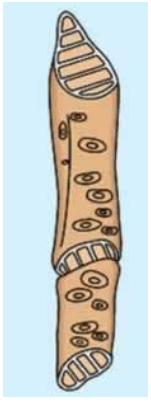
Tracheids
Long, narrower cells with tapered ends that overlap.
Many pits on walls to pass water from cell to cell

lignin
a phenolic compound adds waterproof properties to cell walls
indigestible by humans/animals only certain bacteria and wood-rotting fungi have enzymes to digest lignin
Transpirational pull:
(evaporation of water from leaves pulls water up the stem during daytime) Used by all plants
Root pressure:
pushes water up the stem at night.
Used by shorter plants
Transpirational pull is possible due to two properties of water:
Water is cohesive
• Water is adhesive
Water molecules attract to each other by hydrogen bonds
Water molecules adhere to hydrophilic surfaces like cell walls
Transpirational pull is explained by
Cohesion – tension theory
Cohesion-tension theory
In the presence of a tension of a pull due to transpiration, the cohesion of water molecules allows them to form a continuous column
guttation
result of root pressure, accumulation of minerals and water on the tip of leaves
Hydathodes
push a droplet of water out due to positive pressure
Both transpirational pull and root pressure are essential
for plants to;
1. Get a supply of water for turgor, photosynthesis, and hydration of tissues in general
2. Get a supply of minerals necessary to maintain
cellular functions (i.e. enzyme activities, structure)
Macronutrients in plants
N, P, K, S, Ca, Mg (C,H, and O are also considered extremely important but not macro or micronutrients)
Micronutrients in plants
Fe, Mn, B, Cl, Zn, Co, Mo
Nitrogen deficiency
Older leaves become yellow, by mobilizing N to young leaves during deficiency
Iron deficiency
Young leaves become yellow because iron is not moved from older leaves during deficiency
Phloem tissue in the vascular bundles is responsible
for
transport of food and other organic compounds
Phloem tissue contains;
Sieve tube elements
Companion cells
Parenchyma cells
Phloem sclerenchyma fibers – dead at maturity
Sieve tube elements
live cells with “no nucleus” Nucleus of the companion cell regulates sieve tube functions
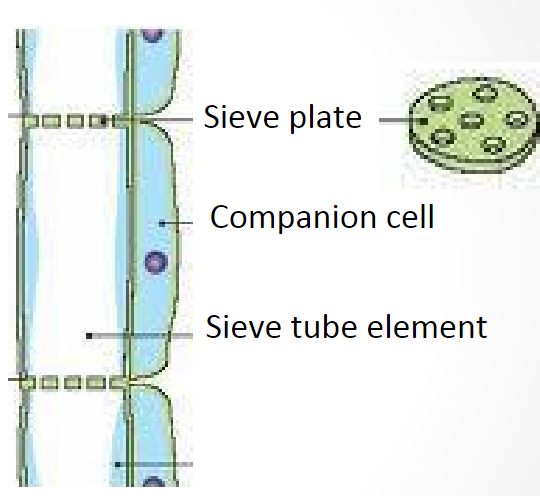
Formation of sieve tube elements and companion cells
Formed by asymmetrical division
Sieve tube elements lose most of the cytoplasmic structures and the nucleus, leaving more room for bulk transport

Transport of sugars and organics happens by
“mass-flow”
(bulk-flow) through sieve tubes from source to sink
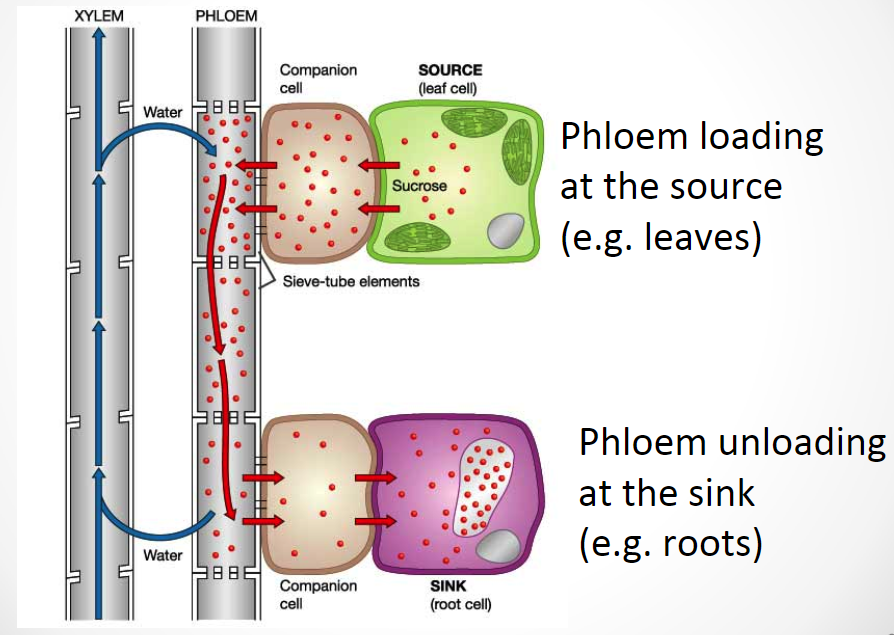
Phloem loading
Sugars loaded to sieve tubes in leaves by companion cells
- Osmosis brings water from nearby xylem tissue
- Pressure builds up in the sieve tube
- Sap is pushed down to the next sieve tube element
Phloem unloading
- When sugars reach roots they are unloaded from sieve tubes
- Water moves back to the xylem by osmosis
Photosynthesis:
Happens in the chloroplasts of all green tissues.
The ultimate source of food for both plants (directly) and animals (indirectly)
Generates oxygen for aerobic cellular respiration
Photorespiration:
This happens in the chloroplasts of many plants as a wasteful process
Reduces the efficiency of photosynthesis
Some species have evolved counter mechanisms to minimize the harmful effects of photorespiration
General reaction of photosynthesis
made up of light dependent and light independent reactions

Light dependent reactions –
Pigments capture light energy and use it to make chemical bonds
Water breaks down and provides electrons
Light independent reactions –
(Calvin Cycle) Use the products of light reactions to fix CO2 into
sugars
Chlorophyll a
reflects green light
Chlorophyll b
reflects some green and yellow
carotenoids:
carotene and xanthopylls
carotene
reflects orange and yellow
xanthophylls
generally reflects a bit less of the same colors as carotenes
thykaloids
carry photosystem II and photosystem I, perform light reactions
a stack of thylakoids is called a grana (inside the chloroplasts)
stroma
liquid inside chloroplasts, contains enzymes to carry out the Calvin cycle to fix CO2
Photosystem II and PS I
produces NADPH+, ATP, and 2 electrons to be used for the Calvin cycle via the electron transport chain, antenna pigments bounce electrons along to do so
PSII and PSI require
H2O to breakdown, producing 2 electrons to continue along the electron transport chain, this breakdown also produces oxygen
the electron transport chain occurs inside the
thykaloid
Summary of light reactions:
Use: light energy, H2O
Produce: ATP and NADPH
Release: O2
ATP and NADPH are needed for
for the Calvin cycle.
Rubisco enzyme
catalyzes CO2 fixation in Calvin cycle
The first organic compound produced from CO2 is the
3 carbon Phosphoglyceric acid (PGA)
C3 photosynthesis is called so due to
the production of PGA, a three carbon compound produced at the beginning of the Calvin cycle
C3 photosynthesis is inefficient due to
occurrence of photorespiration in C3 plants
C3 plants:
All seedless plants
All Gymnosperms
95% of dicots
60% of monocots
Photorespiration occurs because
O2 rich atmosphere, O2 binds to rubisco, inhibiting Calvin cycle (occurs at higher rates in hot, dry climates), decreases the output of carbon
C4 pathway:
Separates O2 releasing PSII from Calvin cycle
CO2 is concentrated in cells that perform the Calvin cycle, About 5% of dicots and 40% of monocots have evolved C4 photosynthesis
C4 mostly occurs in
hot, dry climates that promote photorespiration
C4 utilize:
specialized “kranz” anatomy
C4 mechanism:
Mesophyll cells fix CO2 into 4-carbon oxaloacetate and then into malate
Malate travels to bundle sheath cells, allowing Rubisco and the Calvin cycle to carry out, malate breaks down, releasing CO2 required for Calvin cycle
C4 reduces photorespiration via
carrying out PSII and PSI, but no calvin cycle in the mesophyll cells → producing malate → and the bundle sheath cells carrying out only PSI and Calvin cycle (isolates the Calvin cycle and rubisco from O2, increasing efficiency)
Examples for C4 plants:
sugarcane,
corn
sorghum
CAM pathway
CAM pathway conserves water by opening stomata at night , Crassulacean Acid Metabolism
CAM pathway mechanism:
stomata close during day (less water loss), plants perform Calvin cycle and light dependent reactions, malate breaks down for CO2 → stomata open at night, plants take in CO2 fix into oxaloacetate then breaks down to malate, malate is then stored in the vacuole.
CAM pathway acidity
plant will become more acidic at night and more neutral during the day
C4 pathway plants vs. CAM pathways
Physically separated
Happens in different cells
vs.
Temporally separated
Happens in the same cell